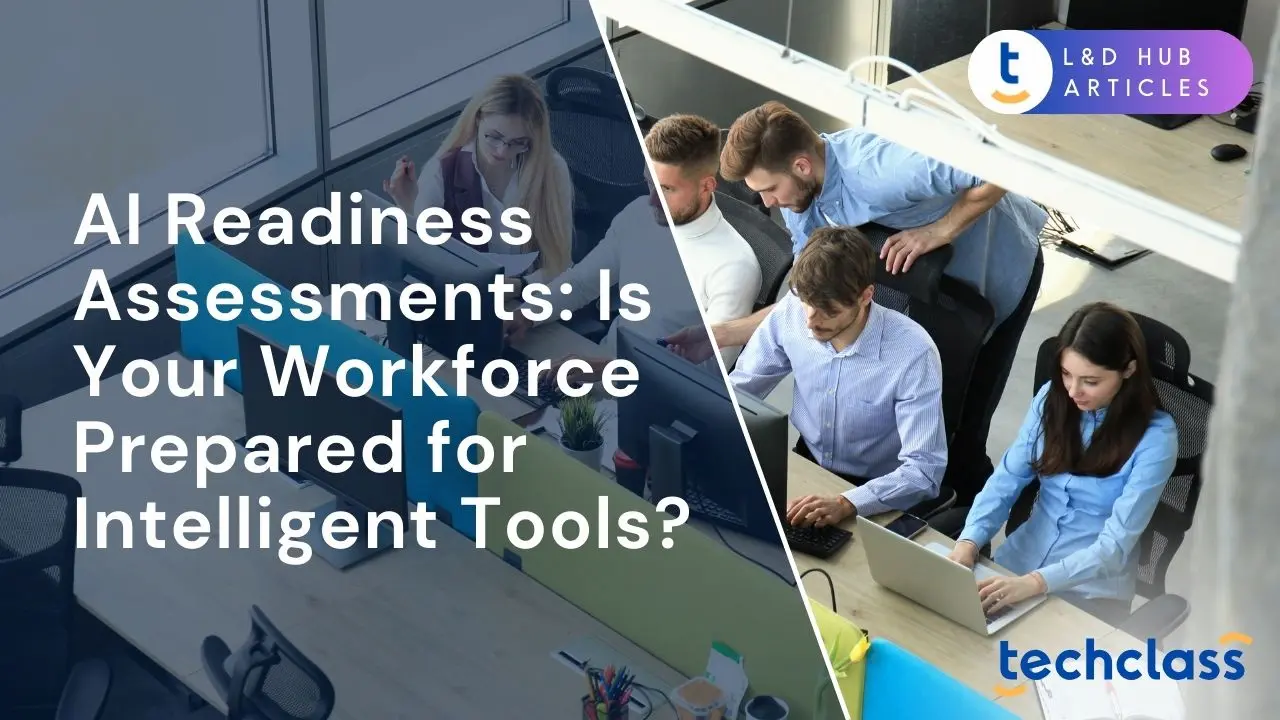
Artificial intelligence is rapidly reshaping how businesses operate, from automating routine tasks to enhancing decision-making, but is your workforce truly ready to harness these intelligent tools? Many organizations are investing in AI technologies, yet research reveals a glaring readiness gap. One global survey of C-suite leaders found that only 10% of companies qualify as “future-ready,” with structured plans to support workers, build AI skills, and lead through AI-driven disruption. In other words, the vast majority of businesses have not fully prepared their people for the AI revolution.
This readiness gap isn’t due to lack of interest in AI, if anything, urgency is higher than ever. Leaders know they must act fast to stay competitive, and 60% of executives expect employees to update their skills for AI. Unfortunately, over a third of companies (34%) have no policies or guidelines on AI use in place. The result is a workforce often left to figure out AI on their own, leading to inconsistent adoption, fear and misuse of new tools, and missed opportunities. To bridge this gap, organizations are turning to AI readiness assessments as a first step in gauging preparedness. These assessments help business and HR leaders understand where their workforce stands, in skills, mindset, and governance, and what needs to be done to prepare employees for an AI-enabled future.
In this article, we’ll explore what AI readiness means for your workforce and why it matters. We’ll look at the current state of workforce AI preparedness (spoiler: there are both exciting advances and concerning shortfalls). We’ll break down the key dimensions to assess, from technical skills and AI literacy to culture, leadership, and ethical guidelines. Finally, we’ll provide practical strategies to help HR professionals, CISOs, business owners, and enterprise leaders build an AI-ready workforce. By the end, you should have a clear roadmap for evaluating your organization’s readiness and taking actionable steps to ensure your people are prepared to thrive alongside intelligent tools.
An AI readiness assessment is a structured evaluation of how prepared your organization, particularly your workforce, is to adopt and integrate AI technologies. Unlike a simple tech checklist, a true AI readiness assessment looks holistically at people, processes, and policies. It examines whether employees have the necessary skills and knowledge to use AI tools, whether the company culture is open to AI-driven change, and whether proper governance is in place to guide AI use. In essence, AI readiness encompasses all the elements needed to prepare an organization for AI, from skills training to workflow adjustments and ethical guidelines. It’s not just about buying software; it’s about ensuring your business and your people can actually leverage AI effectively in their roles.
Workforce-focused AI readiness assessments often involve surveys, interviews, and skill evaluations. For example, some organizations use an “AI Quotient (AIQ)” survey to gauge current employee skill levels and cultural attitudes toward AI. The data from such an assessment can highlight skill gaps (e.g. lack of data literacy or AI tool experience), pinpoint areas of employee apprehension or misconception about AI, and reveal whether leadership and HR policies are aligned to support AI adoption. Armed with these insights, leaders can create targeted plans, like training programs or change management initiatives, to address the gaps before rolling out new AI systems.
In short, an AI readiness assessment asks: Is your workforce prepared for intelligent tools, and if not, what must change? It provides a baseline measurement of readiness across key dimensions, so you can take a proactive, structured approach to AI implementation. Skipping this step is like launching a new technology without checking if anyone knows how to use it or if the company is culturally ready, a recipe for low adoption and frustration. As we’ll see next, the importance of workforce readiness can’t be overstated, given what’s at stake for businesses in the AI era.
Adopting AI is not just an IT project, it’s a people project. No matter how powerful an AI tool is, its value depends on how people use it. This is why workforce readiness is now a top concern for business leaders. In fact, global executives rank the inability of workforce strategies to keep pace with AI disruption as the number one talent risk to growth. Organizations that fail to prepare their employees for AI risk seeing poor returns on their technology investments and may even fall behind competitors.
Consider the current environment: companies are rushing to implement AI for efficiency and innovation gains, yet many employees feel uncertain or left behind. Leaders might assume their teams will “figure it out,” but evidence shows otherwise. According to a recent Gallup workplace survey, 44% of employees say their organization has started integrating AI, but only 22% say there is a clear plan or strategy for it, and just 30% report having any guidelines or policies on AI use. In other words, many workers are being asked to embrace AI without proper guidance or training, a gap that can breed confusion and misuse.
The business implications of an unready workforce are significant. Without training or clear direction, employees may under-utilize AI tools or make mistakes (for example, inadvertently introducing bias or security risks). Indeed, employees often end up using AI without “guardrails”, and when they don’t have the tools or rules they need, over half say they’ll find alternative workarounds (like using unauthorized AI apps), a scenario that invites security risks and chaos. Conversely, organizations that invest in readiness see tangible benefits: higher productivity, more innovation, and greater employee confidence. Research by the Adecco Group found that “future-ready” companies (the 10% with robust AI workforce strategies) are far more confident in their AI implementations and are already outperforming others. These companies treat AI adoption as a human-centric transformation, not just a tech upgrade, aligning talent development, change management, and leadership vision with their AI ambitions.
Ultimately, workforce AI readiness matters because it is the linchpin between AI potential and AI payoff. Without prepared people, even the best technology will deliver disappointing results. With a prepared, agile workforce, however, AI can truly augment human capabilities, freeing employees from drudgery to focus on creative, strategic work, and enabling the organization to innovate faster. In sum, assessing and investing in readiness is essential to ensure that AI tools actually amplify performance rather than gather dust or, worse, cause harm. The next section examines where organizations stand today on this readiness spectrum.
How prepared are most workforces for AI right now? The answer is mixed, there’s momentum in AI adoption, but significant gaps in readiness remain. On one hand, employee use of AI is rising rapidly. A June 2025 Gallup study reported that the share of U.S. employees using AI at work at least occasionally nearly doubled from 21% to 40% in two years. In particular, 27% of white-collar workers now use AI frequently, up sharply from the year before. This suggests many employees are eager to leverage AI tools in their day-to-day tasks. Frontline workers, however, lag behind, only about half of frontline employees use AI regularly, a plateau that Boston Consulting Group dubbed a “silicon ceiling” in adoption.
On the other hand, organizational support and preparedness have not kept pace with this surge in AI usage. As noted earlier, relatively few employees say their companies have provided a clear AI strategy or policies. Many workers are forging ahead using AI without guidance, training, or clarity on best practices. This manifests in several worrying ways:
The net effect of these trends is a classic readiness paradox: employees are adopting AI tools (sometimes out of necessity or curiosity), but many feel unprepared and unsupported, while companies push for AI benefits but haven’t fully prepared their people to capture those benefits. There’s a risk that this disconnect leads to disillusionment, AI projects not meeting expectations, or employees misusing tools, which can stall further progress.
Yet, there are also clear opportunities visible in the data. When organizations do take the right steps, the payoff is evident. For example, Gallup found that when **leadership communicates a clear AI plan, employees are 3× more likely to feel very prepared to work with AI and much more comfortable using it. Similarly, BCG reports that strong leadership support can raise the percentage of employees who feel positive about AI from 15% to 55%, but currently only about 25% of employees say they receive such support. These insights underline where companies should focus their efforts to close the readiness gap. In the next section, we break down those focus areas into key dimensions of AI readiness that every enterprise should assess.
AI readiness is multi-faceted. When assessing whether your workforce is prepared, consider these key dimensions (the “pillars” of AI readiness):
By evaluating these dimensions, an AI readiness assessment paints a comprehensive picture of preparedness. For instance, you may discover that your tech infrastructure is solid (tools dimension), but employees lack confidence and training to use those tools (skills and culture dimensions). Or perhaps your employees are personally eager and experimenting with AI (culture), but management hasn’t put any governance in place (policy dimension). Each organization’s strengths and weaknesses will differ. The key is to identify them upfront so you can target your readiness-building efforts where they’re most needed.
In practice, some organizations score their readiness across such pillars to identify if they are “AI leaders” or “laggards.” Cisco’s global readiness index, for example, benchmarks companies on talent and culture (people-centric pillars) in addition to strategy and technology factors. Whether formally scored or not, your goal is to ensure no critical pillar is neglected. Next, we’ll discuss how to improve on these dimensions, concrete strategies to boost your workforce’s AI readiness.
Closing the AI readiness gap is an achievable goal with a clear plan and commitment. Here are several practical strategies and best practices for HR leaders, CISOs, and business executives to prepare their workforce for AI, organized as key initiatives you can undertake:
By implementing these strategies, organizations can move the needle on all the readiness dimensions we outlined. HR leaders will play a pivotal role, from training and change management to revising job roles and hiring for new skills. CISOs and IT leaders will ensure the tools and policies enable safe usage. Business owners and executives set the tone and allocate resources to these efforts, tying them to business goals. The end result is a workforce that views AI as an empowering part of their job, not a threat or burden. In the final section, we’ll wrap up with some closing thoughts on the journey toward an AI-ready organization.
The age of intelligent tools is here, and it’s changing the nature of work across industries. As we’ve discussed, achieving AI success is as much about people readiness as it is about technology. Forward-thinking organizations are realizing that investing in their workforce, through skill development, cultural change, and strong guidance, is non-negotiable for unlocking AI’s full potential. Those that neglect this will likely stumble. The encouraging news is that humans are adaptable: with the right support, employees can and do rise to the challenge of new technology. We see evidence that when given training, clear strategy, and leadership support, workers embrace AI and even become champions of innovation.
For HR professionals, CISOs, and business leaders reading this, the imperative is clear. Start by assessing your current state, honestly and thoroughly. Use the insights from an AI readiness assessment to create a tailored action plan. Address the fears with knowledge. Address the confusion with communication. Address the skill gaps with training. Address the misuse risks with policy. In doing so, you create a solid foundation on which AI initiatives can flourish. Remember that AI readiness is not a one-time checkpoint but a continuous journey of learning and adaptation. The technology will keep evolving, and so will the skills required, which means fostering a culture of lifelong learning is perhaps the most valuable long-term investment of all.
Preparing your people for intelligent tools ultimately turns AI from a shiny object into a truly transformative asset. It ensures that your organization doesn’t just have AI capabilities in theory, but in practice, embedded in daily workflows, driving better decisions, and augmenting human talent at every level. With an AI-ready workforce, you position your business to innovate faster, execute more efficiently, and remain resilient amid the disruptions that AI will inevitably bring. In the end, AI readiness is about empowering your employees to work with intelligent machines in a harmonious partnership. By doing so, you prepare not just for the tools of today, but for the unforeseen opportunities of tomorrow’s intelligent workplace.
An AI readiness assessment is a structured evaluation that measures how prepared an organization’s workforce is to adopt and use AI tools effectively. It goes beyond technology checklists, examining employee skills, company culture, leadership vision, and governance policies to ensure both people and processes can leverage AI successfully.
Workforce readiness is essential because AI adoption is ultimately a people-driven transformation. Without the right skills, strategies, and support, even the best AI tools can fail to deliver value. Prepared employees boost productivity, foster innovation, and help organizations achieve a strong return on AI investments.
Common gaps include low AI literacy, limited training, lack of clear policies or ethical guidelines, and insufficient leadership communication. Many employees use AI without proper guidance, leading to inconsistent adoption, security risks, and missed opportunities.
The five core pillars are skills and AI literacy, culture and mindset, leadership and strategy, policies and ethics, and tools and infrastructure. These dimensions ensure employees have the knowledge, openness, guidance, governance, and resources to use AI effectively in their daily work.
Organizations can improve AI readiness by investing in AI education, fostering a growth mindset, communicating a clear AI vision, establishing ethical guidelines, providing secure and useful tools, and continuously monitoring progress. These actions build both competence and confidence in using AI.

.webp)
